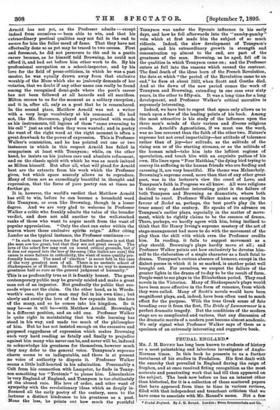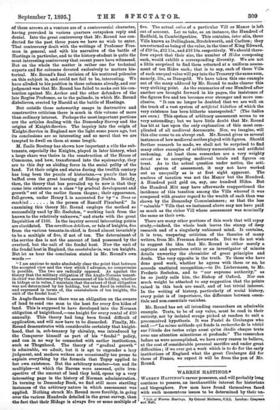FEUDAL ENGLAND.*
MR. J. H ROUND has long been known to students of history as a most painstaking and laborious investigator of Anglo- Norman times. In this book be presents to us a further instalment of his studies in Feudalism. His first dealt with the anarchy that prevailed in England during the reign of Stephen, and at once received fitting recognition as the most accurate and penetrating work that had till then appeared on the subject. The book now before us has an interest other than historical, for it is a collection of those scattered papers that have appeared from time to time in various reviews, filled with that independent and trenchant criticism that we have come to associate with Mr. Round's name. Not a few • Feudal England. By T. II. Round. London: Swan Sonneneeheia and 0o. of these arrows at a venture are of a controversial character, having provoked in various quarters outspoken reply and denial. Into the great controversy that Mr. Round has con- ducted for the past three years we have no wish to enter. That controversy dealt with the writings of Professor Free- man in general, and with his narrative of the battle of Hastings in particular, and to the history-student is quite the most interesting controversy that recent years have witnessed. But on the whole the matter is rather one for technical experts and for columns devoted exclusively to matters his- torical. Mr. Round's final revision of his scattered polemics on this subject is, and could not fail to be, interesting. We have alluded to his position in these columns already, and our judgment was that Mr. Round has failed to make out his con- tention against Mr. Archer and the other defenders of the late Regina Professor, as to the palisade, in which Mr. Round disbelieves, erected by Harold at the battle of Hastings.
But outside these noteworthy essays in destructive and constructive criticism there is much in this volume of more than ordinary interest. Perhaps the most important portions are the articles dealing with the Domesday Survey and the origins of Knight-Service. The inquiry into the origin of Knight-Service in England saw the light some years ago, but its conclusions are so interesting and so novel that we are tempted to dwell on them at some length.
M. gmile Boutmy has shown how important a role the sub- tenants, especially the Knights, played in later history, what a large share was theirs in the construction of the House of Commons, and how, transformed into the squirearchy, they are to this day an abiding force in the social polity of the land. Yet their origin and status during the twelfth century has long been the puzzle of historians,—a puzzle that has baffled even the great learning of Bishop Stubbs. Briefly, then, the theory that has prevailed np to now is that they came into existence as a class "by gradual development and growth" out of the earlier Saxon thegns ; their appearance, full-grown, under Henry I. is accounted for by " a Deus ex snachind in the person of Ranulf Flambard." In examining this theory Mr. Round employs the method so successfully used by Mr. Seebohm, " working back from the known to the relatively unknown," and starts with the great Inquisition of 1166. In the inquiry several interesting points are elucidated. The servitiuns debit um, or tale of knights, due from the various tenants-in-chief, is found almost invariably to be a multiple of five, if not of ten. The determinant of the service due is not the amount of land possessed by the overlord, but the unit of the feudal host. Now the unit of the feudal host in England, the constabularia, was ten knights. But let us hear the conclusion stated in Mr. Round's own words :—
" I am anxious to make absolutely clear the point that between the accepted view and the view which I advance, no compromise -is possible. The two are radically opposed. As against the theory that the military obligation of the Anglo-Norman tenant- in-chief was determined by the assessment of his holding, whether in hidage or in value, I maintain that the extent of that obligation was not determined by his holding, but was fixed in relation to, and expressed in terms of, the constabularia of ten knights, the unit of the feudal host."
In Anglo-Saxon times there was an obligation on the owners of land to send one man to the host for every five hides of land. This is supposed to have developed into the Norman obligation of knighthood,—one knight for every rental of £20 annually. This theory had long been found difficult of application, and will now have to be discarded. Finally, Mr. Round demonstrates with considerable certainty that knight- hood, that is, sub-tenancy by chivalry, was introduced by the Conqueror himself as part of his " feudal " policy, and can in no way be connected with earlier institutions, such as Thegnhood. The theory of " gradual growth " -is admirable, we admit, but it is apt to engender a lazy judgment, and modern writers are occasionally too prone to explain everything by the formula that Topsy applied to her own existence. But the arbitrary number—ten and its multiples—at which the Barons were assessed, quite irre- spective of the amount of land they held, opens up a very interesting page in the history of Norman administration. In turning to Domesday Book, we find still more startling instances of the arbitrary nature in which assessment was applied. Nothing struck Mr. Round more forcibly, in going over the various Hundreds detailed in the great survey, than the fact that their Hidage is always five or some multiple of five. The actual value of a particular Vill or Manor is left out of account. Let us take, as an instance, the Hundred of Radfield, in Cambridgeshire. This contains, inter alia, three Ville known as Dullingham, Stretchworth, and Carlton; they are returned as being of the value, in the time of King Edward, of £19 5s., £12 15s., and £1810s. respectively. We should there- fore expect that their size, the number of Hides composing each, would exhibit a corresponding diversity. We are not a little surprised to find them returned at a uniform assess- ment of ten Hides each ; that is to say, each of these Vills of such unequal value will pay into the Treasury the same sum, namely, 20s., as Danegeld. We have taken this one example out of the many adduced by Mr. Round to make clearer this very striking point. As the summaries of one Hundred after another are brought forward in his pages, the insistence of the figures five and ten becomes ever stronger and more con- clusive. " It can no longer be doubted that we are well on the track of a vast system of artificial hidation of which the very existence has been hitherto unsuspected." (The italics are ours.) This system of arbitrary assessment seems to us very astounding ; but we have little doubt that Mr. Round has hit at last upon the only explanation of this most com- plicated of all mediaeval documents. Nor, we imagine, will this clue come to an abrupt end. Mr. Round gives us several instances of how mediaeval scribes played with figures. Should further research be made, we shall not be surprised to find many other examples of arbitrary numeration and artificial reckoning. At least these researches are a very weighty caveat as to accepting mediaeval totals and figures on trust. As to the actual question under notice, the arti- ficial system of assessment, it may not have worked out as unequally as is at first sight apparent. The nucleus of taxation was not the Manor but the Hundred. A Hundred paid geld on, say, one hundred Hides. But the Hundred Met may have afterwards reapportioned the incidence of this taxation among the Ville whereof it was composed with greater regard to the wealth of each than was shown by the Domesday Commissioners ; so that the less " valuable " Villa that we instanced above may not have paid as much as the richer Vill whose assessment was nominally the same as their own.
There are many other portions of this work that will repay study,—indeed, the whole book leaves the stamp of deep research and of a singularly unbiassed mind. It contains, it is true, unsparing criticism of the theories of many writers, from Mr. Freeman downwards. But we do not wish to suggest the idea that Mr. Round is either merely a captious and querulous critic or an investigator of minute details unworthy the chronicler of great principles and deeds. The very opposite is the truth. To those who have done good work, whether he agrees with them or no, he accords unstinted recognition,—to Dr. Liebermann, to Mr. Frederic Seebohm, and to " our supreme authority," as he so justly calls him, the Bishop of Oxford. Nor can much weight be attached to any suggestion that the points raised in this book are small, and of but trivial interest. In the writing of history, particularly of social history, every point is of importance, the difference between essen- tials and non-essentials vanishes.
Mr. Round has set all intending researchers an admirable example. Texts, to be of any value, must be read in their entirety, not by isolated scraps picked at random to suit a preconceived hypothesis. It was Finite' de Coulanges who said :—" La meme methode qui fonde la recherche de in verit6 sur l'etude des textee exige aussi qn'on etnclie cheque texte avec une attention minutieuse et profonde." The researches before us were accomplished, we have every reason to believe, at the cost of considerable personal sacrifice and under great difficulties ; if we ever get a work which is to do for the early institutions of England what the great Coulanges did for those of France, we expect it will be from the pen of Mr. Round.



































 Previous page
Previous page